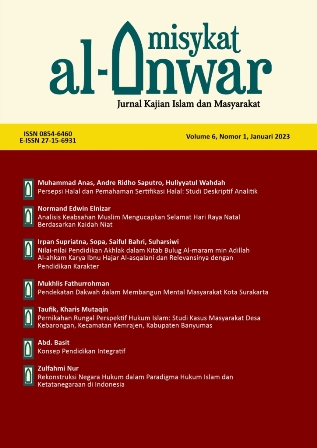Pernikahan Rungal Persfektif Hukum Islam: Studi Kasus Masyarakat Desa Kebarongan, Kecamatan Kemrajen, Kabupaten Banyumas
Main Article Content
Abstract
Article Details
All manuscripts published in the Misykat al-Anwar Journal of Islamic Studies and Society are entirely the property of the author, as for the entry and unpublished script of the journal, the copyright is wholly the property of the author.
All manuscripts published in the Misykat al-Anwar Journal of Islamic Studies and Society are open to the public by following the provisions of the CC-BY-NC-SA (Attribution Non Commercial Share Alike) platform where everyone is allowed and permitted to adapt, the results of the study with the provision should provide citation credit to the author (citation) not for commercial purposes, and one must make a similar provision to the results of his research.
---
Semua naskah yang diterbitkan dalam Misykat al-Anwar Jurnal Kajian Islam dan Masyarakat sepenuhnya menjadi hak milik penulis, adapun naskah yang masuk dan belum diterbitkan oleh jurnal, hak cipta sepenuhnya milik penulis.
Semua naskah yang diterbitkan dalam Misykat al-Anwar Jurnal Kajian Islam dan Masyarakat terbuka untuk umum (open access) dengan mengikuti ketentuan platform CC-BY-NC-SA (Attribution Non Commercial Share Alike) semua orang diperbolehkan untuk menyadur, merujuk dan mengadaptasi tulisan/hasil penelitian dengan ketentuan harus memberikan kredit rujukan kepada penulis (citation) bukan untuk kepentingan komersial, dan seseorang harus melakukan ketentuan yang serupa terhadap hasil penelitiannya.
References
Abdullah, Sulaiman,. (2007). Sumber Hukum Islam, Jakarta: Sinar Grafika Offset
Ali, Abdul Karim Ibn. (1999). al-Muhaddzab fī Ulūm Uṣūl Fiqh al-Muqāran. Riyadh: Maktabah al-Rushd
Aulawi, Arso Sosroatmodjo dan A.Wasit. (1975). Hukum Pernikahan di Indonesia. Jakarta: Bulan Bintang
Aziz, Safrudin. (2017). “Tradisi Pernikahan Adat Jawa Keraton Membentuk Keluarga Sakinah”. Ibda’ Jurnal Kebudayaan Islam, 15 (1 )
Dahlan, Djamaludin Arra’uf bin. (2011). Aturan Pernikahan dalam Islam, Cetakan 1. Jakarta: Jal Publishing,.
Fauzi, Ahmad, (2010). Respon Masyarakat Keluarahan Pasir Putih Kecamatan Sawangan Kota Depok Terhadap Nikah dengan Melangkahi Kakak Kandung”, Jakarta: UIN Syarif Hidayatullah, skripsi
Firdaus, (2004). Uṣūl Fiqh: Metode Mengkaji dan Memahami Hukum Islam Secara Komprehensif, Jakarta: Zikrul
Hadikusuma, Hilman, Hukum Perkawinan Adat, cet ke-4, Bandung: Aditya Bakti, 1990
al-Manzur, Ibn. Lisan al-Arab. Bairut: Dar Lisan al-Arab, n.d.
Mawardi, Kholid. "“Seni Sebagai Ekspresi Profetik”." Ibda’ Jurnal Kebudayaan Islam, 11 ( 2)
Nashirudin, Mohammad, Efektifitas Undang-undang No.1 Tahun 1974 Tentang Perkawinan”, Ponorogo: STAIN Ponorogo, skripsi: 2015
Nur Aini, Siti . (2015). Tinjauan Hukum Islam Terhadap Tradisi nglangkahi dalam pernikahan, Salatiga : IAIN Salatiga
Ridwan. “Mistisisme Simbolik dalam Tradisi Islam Jawa”." Ibda’ Jurnal kebudayaan Islam, 6 ( 1)
Tim Penyusun Kamus Pusat Pembinaan dan Pengembengan Bahasa. (1988). Kamus Besar Bahasa Indonesia. Jakarta: Balai Pustaka
Zahro, Abu. (2011). Ushul Fiqh cet ke-14. Jakarta: Pustaka Firdaus
Zaidan, Abdul Kariem. (2006). Al-Wajīz fii Uṣūl al-Fiqh. Beirut: Muassasah al-Risālah
Zuhaili, Wahbah. (1986). Uṣūl Fiqh al Islam Jilid 1. Syria: Dar el-Fikri
